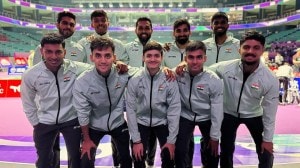- India
- International
Battle-ready: Kejriwal’s transition from the perpetual protester to the affable family man
Beaming from billboards, steering clear of personal attacks, focused on development, and refusing to be drawn into national debates, it’s a new Arvind Kejriwal to the forefront. The Indian Express tracks the careful transition of the perpetual protester to the affable family man, in AAP’s preparation for Delhi polls
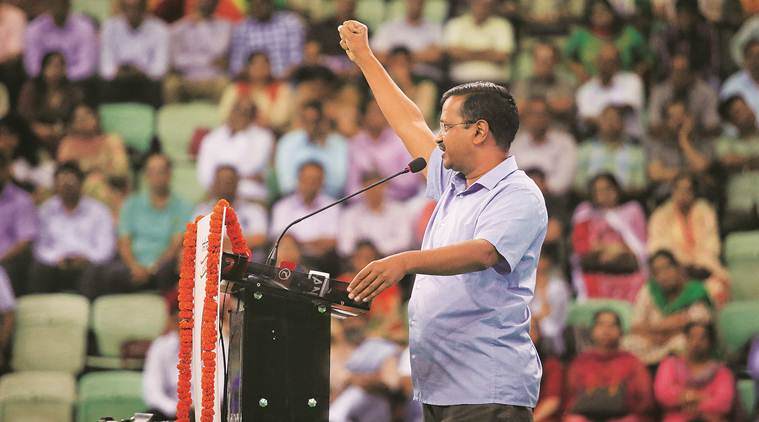 Chief Minister Arvind Kejriwal addressing teachers at the launch of the Delhi government’s ‘Constitution at 70’ campaign. (Express photo: Praveen Khanna)
Chief Minister Arvind Kejriwal addressing teachers at the launch of the Delhi government’s ‘Constitution at 70’ campaign. (Express photo: Praveen Khanna)
EXACTLY six years ago, during his 49-day first term as chief minister, Arvind Kejriwal spent 30 hours outside Rail Bhawan on the road, protesting against police officials. The image of him cuddled in a mattress through the night there, and later holding a nine-hour sit-in inside Raj Niwas, were milestones in the Aam Aadmi Party and the Capital’s politics. It’s a sign of how far Kejriwal has come as a politician that as another day-night protest is waged on the chilly streets of Delhi for nearly a month now, the Delhi CM has chosen to support from a distance.
As the BJP once again repeats its charge of lawlessness against him over the anti-Citizenship Amendment Act (CAA) protests, calling the Battle for Delhi a battle between “nationalists” and “anarchists”, Kejriwal refuses to be drawn in. On Friday, asked about his absence from the protests, he said, “People voted for me for Delhi’s development. I was trying to ensure there is no violence anywhere.”
Read | Amid politics, mega PTM at Delhi govt schools goes as planned
With elections in the Capital only days away, the stakes for both parties are high. Delhi had been among the first defeats of the Narendra Modi-led BJP post the 2014 general election sweep. In the five years since that February 2015 election, AAP has kept the BJP on the toes in Delhi and mostly a few steps behind, matching it optics-for-optics, scheme-for-scheme, and keeping the focus on vikas. The BJP, additionally, is entering this election buffeted by a series of poll losses.
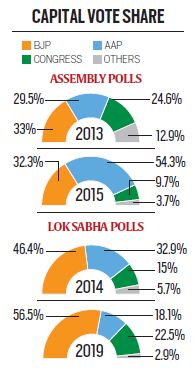
Now slow, steady
For AAP, which surprised even itself with the 67/70 seats endorsement last time, it is a chance to prove that wasn’t a fluke. Having been disappointed in its national ambitions since, it is now focused only on Delhi. A repeat victory is its only re-launch pad.
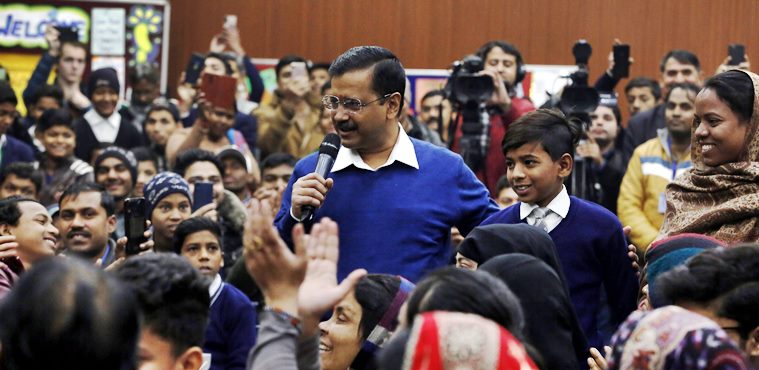 Delhi CM Arvind Kejriwal interacts with a student during a mega-PTM (Parents Teachers Meeting) at Sarvodaya Bal Vidyalaya, Rouse Avenue. (Express photo: Amit Mehra)
Delhi CM Arvind Kejriwal interacts with a student during a mega-PTM (Parents Teachers Meeting) at Sarvodaya Bal Vidyalaya, Rouse Avenue. (Express photo: Amit Mehra)
And characteristically, if the BJP has sounded the bugle with a big rally by Prime Minister Narendra Modi at Ramlila Maidan, Kejriwal has started town hall gatherings, one for each of the Capital’s seven Lok Sabha seats.
***

The change has been a while coming — some of it staring Delhi, literally, in the face.
For some months now, the AAP government has flooded newspapers with full-page advertisements and Delhi streets with billboards projecting its numerous schemes, and featuring a beaming Kejriwal.
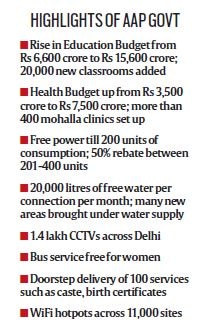
Sources say a decision has been taken to upload only smiling images of the CM on his social media accounts, including Twitter and Instagram, even as a dedicated team captures moments that people can relate with.
“The idea is to make Kejriwal likeable. So you can see him worshipping Laxmi on Diwali with his wife, daughter, son, father and mother. At other times, wife Sunita Kejriwal uploads pictures. The attempt is to project Kejriwal the family man. And it’s not a celebrity family, but one that eats together, prays together, just like any other family,” an AAP leader says.
In the process, the perpetually angry Kejriwal, who built his political career as a protester, has given way to a mild-mannered CM, “elder son” to many, “elder brother” to some, a connection he makes repeatedly in his speeches. The leader who constantly attacked Modi, badmouthed corporates and took on bureaucrats, who burnt a copy of the UPA’s Lokpal Bill in public, is gone.
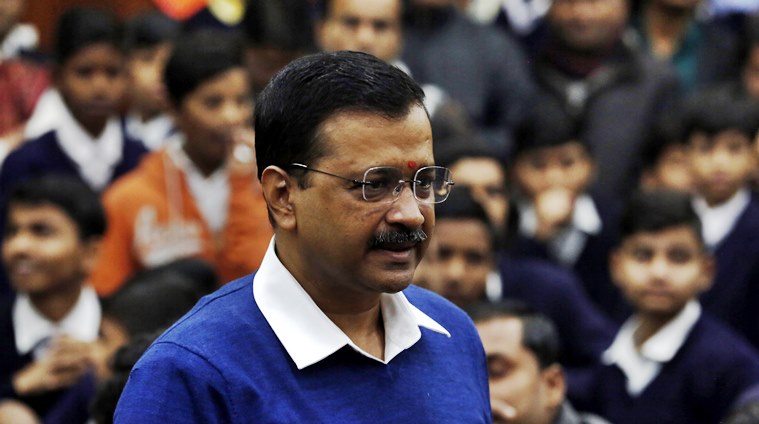 As the BJP once again repeats its charge of lawlessness against him over the anti-Citizenship Amendment Act (CAA) protests, calling the Battle for Delhi a battle between “nationalists” and “anarchists”, Kejriwal refuses to be drawn in. (Express photo: Amit Mehra)
As the BJP once again repeats its charge of lawlessness against him over the anti-Citizenship Amendment Act (CAA) protests, calling the Battle for Delhi a battle between “nationalists” and “anarchists”, Kejriwal refuses to be drawn in. (Express photo: Amit Mehra)
Kejriwal addressed this change at his Friday Town Hall gathering, saying, “I have no interest in hurling abuses at anyone, but I will stand up when society is wronged.”
AAP leaders direct you to an October Facebook Live session of Kejriwal’s. When the cameras start rolling, the unsuspecting CM has a frown on his face. Realising he is on air, that swiftly melts into a warm smile. Through the next nine minutes, the smile doesn’t slip as Kejriwal talks about his government’s plan for free rides for women in public buses.
Says a member of the team looking after Kejriwal’s image management, “Despite all odds, many of our projects were successful, but we were unable to seize the narrative. The impression that we were good in activism and poor in government was gaining ground.”
That belief was cemented by successive poll setbacks in 2017, when the AAP candidate lost his deposit in the Rajouri Garden by-election and the party with 26% of the votes finished behind the BJP’s 37% in the municipal polls.
Since ending up behind the BJP as well as the Congress in vote share in the 2019 Lok Sabha elections as well, Kejriwal has shied away from any personal attacks on the PM or Amit Shah, the team he once dubbed “the dangerous duo”.
The party is instead focusing on the government’s uncontested accomplishments in education and health, and to some extent, in power and water. The regularisation of unauthorised colonies, a long-pending promise that was finally fulfilled in the run-up to the polls, was seen as the BJP’s response to AAP. However, AAP is as loudly laying claim to it. Since the Union government pitched in to hand over registry deeds to 20 families, AAP has been arguing that conferment of these ownership rights to residents means little in the absence of actual regularisation of these settlements.
On December 14, came another message from AAP that it was taking the battle to the BJP camp. The party announced that its campaign had hired the advocacy group, I-PAC, of Prashant Kishor — one of the men credited with Modi’s 2014 win.
The release of the AAP government’s ’report card’ soon after was seen as I-PAC’s brainchild, as is the three-layer campaign planned next — door-to-door visits, corner meetings and Kejriwal’s town halls.
“In today’s age, one needs to have various ideas and technological interventions during polls. Kishor bring that expertise on board. We hope to benefit from his experience. I-PAC is helping us introduce innovative elements in our campaign. We are open to each other’s suggestions on every campaign related issue. There are no restrictions,” AAP Rajya Sabha MP Sanjay Singh, the party’s Delhi election in-charge, said.
***
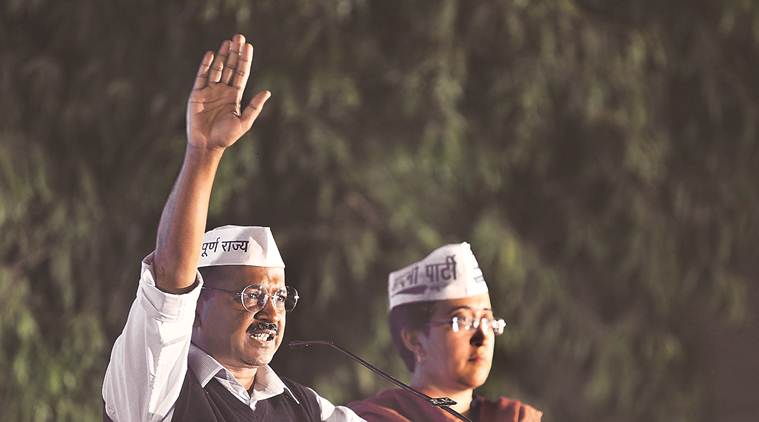 CM Arvind Kejriwal, East Delhi Lok Sabha candidate Atishi at a jan sabha in Laxmi Nagar. (Express photo by Gajendra Yadav)
CM Arvind Kejriwal, East Delhi Lok Sabha candidate Atishi at a jan sabha in Laxmi Nagar. (Express photo by Gajendra Yadav)
Over the years, Kejriwal has been accused of losing several close lieutenants to his authoritarian approach — including Yogendra Yadav, Prashant Bhushan, Ashutosh, Ashish Khetan, and political advisor Ashish Talwar. It was one of the reasons AAP disintegrated in Punjab, the other state that showed surprising faith in it.
However, many others have stayed with Kejriwal from his India Against Corruption days, and it’s some of them who are leading the transformation even as the AAP chief himself mellows down.
If Singh and state Labour Minister Gopal Rai are in-charge of a team working closely with the Delhi CM to recast Kejriwal’s, as well as the Delhi government’s image, giving support, are Delhi Dialogue and Development Commission vice-chairman Jasmine Shah, Atishi and Naru Radhakrishnan, who had an over 12-year stint with Ogilvy & Mather.
Deputy CM Manish Sisodia remains a huge asset with his clean and affable image, driving the AAP government’s education push and earning it goodwill among school students and parents. Sisodia has taken up more party role of late, and has been addressing press conferences regularly.
In the division of duties, Shah, a Columbia University graduate, is driving policy-level changes, while Atishi and Radhakrishnan, both on the board of government’s ad agency Shabdarth, are shaping the government’s narrative, ensuring coverage across all media verticals.
The party’s long-time IT department head Ankit Lal and Pulkit Sharma are among others handling AAP social media campaigns. The Delhi CM’s Facebook page has been getting an average of 5,000 likes a day since a decision was taken to upload posts in the form of stories. The Instagram account, AAP says, adds around 2,000 followers per day.
AAP recently posted, across platforms, photos of Kejriwal helping an elderly woman board a bus, and another one climb onto a dais. Quips a party insider, “In contrast to his public persona, Kejriwal is actually very witty and warm in person. So it’s not as if he is always grumpy. But, of late, he has been smiling a little more than required.”
Atishi adds that Kejriwal is smiling because work is “finally getting done”. “We were facing a concerted attack. To give you one example, the L-G opposed our doorstep delivery of services scheme saying motorbikes of delivery persons on the roads will cause pollution. That same scheme is today winning awards. So the anger was justified. How would he have smiled under such circumstances?”
***
 Lt-Gen Anil Baijal with Chief Minister Arvind Kejriwal in 2018. (Express photo by Abhinav Saha/archive)
Lt-Gen Anil Baijal with Chief Minister Arvind Kejriwal in 2018. (Express photo by Abhinav Saha/archive)
The party sees the Supreme Court verdict of July 2018 curtailing the L-G’s authority in the allocation of powers in Delhi as a boost.
Apart from the doorstep delivery scheme (September 2018), AAP has announced free rides for women in buses, a project to install 2.10 lakh streetlights, started installation of WiFi hotspots across 11,000 sites, inducted over 500 cluster buses, waived electricity charges for those consuming between 0-200 units.
While the free power, water and travel schemes have drawn their share of criticism, including over fiscal prudence, and opposition parties have dismissed them as poll stunts, AAP believes the trick lies in communicating the same to the public.
“The target of these schemes is largely the lower middle class, the poor. So the CM chose the term ‘lifeline power’ while announcing the scheme under which households are not charged for consumption of up to 200 units. We have conveyed that it is about making sure that people of all classes lead dignified lives. Similarly the decision to make public transport free for women is about ensuring upward mobility for them. It may not mean much for the well-off, but in many families men hold the purse strings. For a working class woman, a saving of Rs 1,000 to Rs 2,000 per month is not a small thing,” a person involved with the process says.
The figures so far bolster the Delhi government’s case. While the annual state budget increased from around Rs 30,000 crore in 2015 to over Rs 60,000 crore in 2019, a CAG report, tabled in the Delhi Assembly in December, noted that the state went from a fiscal deficit of around Rs 3,942 crore in 2013-14 to a fiscal surplus of Rs 113 crore in 2017-18. The share of public debt to the GSDP has fallen from 7.23% to 4.89%.
A survey of 2,298 voters in Delhi by the Lokniti programme of the Centre for the Study of Developing Societies (CSDS), in November-December, showed approval for the AAP government on education, health and transport.
An AAP leader, refusing to come on record, says, “The schemes are mostly the brainchild of the CM. But, for the first time, there is a synchronisation between government ads and announcements. There is a big component of public outreach in the campaigns, be it dengue, community Diwali or installation of streetlights. Earlier, the entire government was busy with governance alone. Now we are working very systematically. Tailored messaging has also been adopted for various sets of audiences whose needs and demands vary.”
Says another party leader, “Our policies are geared towards meeting the everyday needs of the common man, be it power, water, travel or security at the mohalla level. We are a household party in that way. His image as the elder son or brother also fits our model of governance and he looks the part, doesn’t he?”
In this makeover, that look has remained a constant, with AAP leaders standing out
in their regular shirts and trousers among a sea of khadi.
***
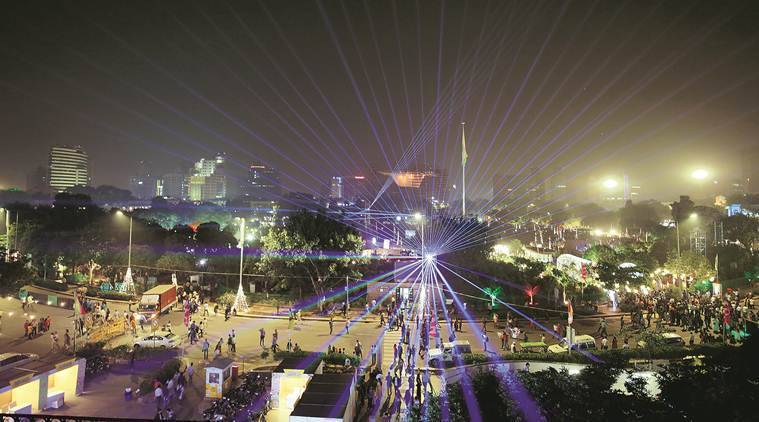 Thousands turned up for the government event at Central Park in Connaught Place, where laser shows and musicals were held every night.
Thousands turned up for the government event at Central Park in Connaught Place, where laser shows and musicals were held every night.
On other matters though, AAP has effortlessly donned more political colours, showing its dexterity despite being new to the game. Having led its entire Lok Sabha campaign on the plank of statehood, the party has now adopted radio silence on the issue. Sanjay Singh, however, defends that statehood remains the party’s core demand. At a town hall gathering on Saturday, Kejriwal said that the demand for statehood will figure in the party’s manifesto for the Assembly polls.
The state Art, Culture and Languages Department has been organising cultural festivals aimed at specific communities, like Poorvanchalis, Jats, Punjabis, and at the unlikeliest venues, breaking away from the Mandi House circuit. “For example we have been organising the Ragini form of theatre in pockets with a high density of Jats. These performances are helping us deliver political messages. The decentralisation of the art circuit means we are catering to their demand, and not thrusting our choices on them,” a government functionary says.
This year, between October 26 and 29, the AAP government held a “community Diwali”. “The idea had come in the form of public feedback on ways to deal with pollution. We did not want to say don’t burst crackers. That would not have worked. Diwali is to be celebrated. So instead, we said, come celebrate together,” the functionary adds. Thousands turned up for the government event at Central Park in Connaught Place, where laser shows and musicals were held every night.
Between November 4-15, the Delhi government implemented the odd-even scheme, with pollution levels peaking after Diwali. Kejriwal later admitted that many AAP MLAs had expressed fears that the license plate policy might cost them politically, but he went ahead “reposing faith on the people of Delhi. Kyunki Delhi ke log bohot achhe hai (Because residents of Delhi are nice people).”
Nearer to the polls, AAP has been doing a balancing act to avoid being trapped into any pre-determined slots by the BJP. It “supported” and “welcomed” the scrapping of J&K’s special status, as well as the Supreme Court verdict paying the way for a temple at the disputed Ayodhya site. While it voted against CAA in Parliament and has opposed it in public, Kejriwal was among the first to project it as anti-poor rather than anti-Muslim. Calling CAA “dangerous”, he asked where would the refugees who become citizens be settled, and how would they be given jobs.
On Friday, urging the entire country to “reject” the law, Kejriwal repeated that it will affect “both Hindus and Muslims”. At what was his fourth town hall gathering, he stressed that the discourse of the country should be on jobs.
Sanjay Singh rejects suggestions that AAP is acting with eye on Hindu votes. “If we go to any protest, and there is even a stray incident of violence,” he said, “the blame will land at our door. That’s why we have been urging people to carry out protests in a democratic way.”
***
However, some party leaders warn that AAP may be deluding itself thinking support will translate into votes. Kejriwal’s rallies ahead of the Lok Sabha polls, for example, had also drawn thousands of people but five of the party’s seven candidates finished last.
“You ran a negative campaign, said things like Modi, Amit Shah would change the Constitution, would not hold any more elections, alleged that the PM wants to kill you, said without statehood Delhi’s development would remain a chimera, then suddenly you change tack, talk about working together. Even a modicum of consistency is absent. What if people see through the supposed transformation?” a party leader asks.
Delhi BJP general secretary Ravinder Gupta says Kejriwal realises that the people of Delhi, just like the entire country, “love and trust Modi”, and hence the change. “He is trying to deceive people by announcing schemes just ahead of elections. But people of Delhi are aware of his original face and they don’t trust him anymore. People are questioning his announcement spree. What was he doing over the last five years?” Gupta says.
The BJP campaign though has been plagued by infighting, particularly over the CM face.
The Congress, which is predicted by most to finish a distant third, says Kejriwal is trying to dodge questions by projecting a reconciliatory image. “The last five years have been a lie. None of the 70 poll promises has been fulfilled. In the Lok Sabha polls, the people of Delhi gave Kejriwal an answer,” says Delhi Congress chief Subhash Chopra. He also claims that the reason for the changed tune of the Delhi CM is that “all his projects and initiatives are being passed by the LG and Centre now”.
Atishi denies the charge of lack of consistency. “The point is Delhi’s statehood will not be decided by the Delhi Assembly. The upcoming polls are for the Assembly… We raised that during the general elections as, in the event of an Opposition coalition coming to power, we could have made some progress on that front,” she says.
Asked about AAP’s national ambitions, Sanjay Singh is honest. “Such decisions are taken based on a state unit’s strength. Currently, our focus is Delhi.” He is ambiguous, however, on whether AAP would tie up with non-BJP parties, like it had done briefly with the Congress. “We have not taken a call on that,” he says.
During a recent interaction with The Indian Express, Sisodia pointed out another changed reality that is giving AAP hope. “The Haryana and Maharashtra results show people are clear about their choices. They know who to vote for in which election,” he said.
Apr 26: Latest News
- 01
- 02
- 03
- 04
- 05
























